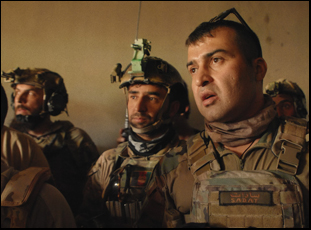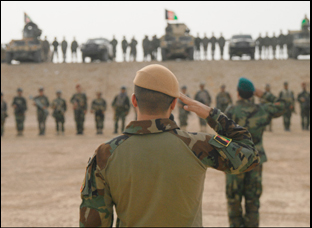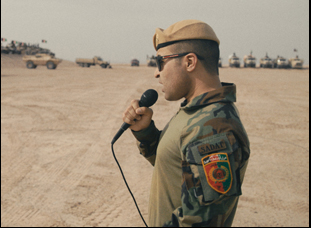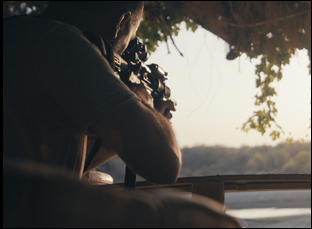There were the obvious reasons that Matthew Heineman gravitated towards Sami Sadat, the National Army general in charge of the ANA Special Operations Command overseeing the Helmand Province in Afghanistan, but the director was intrigued for less obvious ones while embedding in the country to make “Retrograde.”
“He was 35 years old and encountered a lot of stereotypes of what you think of when you think of a two-star general — shorter in stature, had a high pitched voice, he isn’t exactly what you would think of when you think of the Hollywood general, if you will,” says Heineman, who would accompany Sadat as his country fell into chaos upon the United States’ announcement that they would withdraw troops from the decades-long war. “But he was endlessly interesting and a force. Part of the narrative tension in the movie is [having] every neon sign metaphorically saying, ‘Stop, give up, surrender, the country’s falling,” and up until the very end, he failed to believe that.”
This isn’t a judgment on Heineman’s part, when his own work seems like it can only be accomplished by having some blinders to the threats endemic to such highly pressurized environments he covers, yet his unflinching camera will often catch what people operating under such duress may not even see about themselves, taking the enormity of the situations with global implications and making them emotionally tactile to those who feel they are at arm’s length. Heineman arrived in the Helmand Province only months after he had completed filming “The First Wave,” a harrowing look at the damage wrought by COVID-19 from inside a New York hospital struggling to keep up with an influx of patients, and if it was remarkable that he located the one private practice that would allow him in to film for what becomes critical reportage of the pandemic era, his diligence over a number of years to gain access to the Green Berets along with producer Caitlin McNally has resulted in what will surely be looked back on as a definitive portrait of the end of the American mission in Afghanistan and the turmoil that still engulfs the country after the Taliban overtook the government.
Heineman and his intrepid crew embed with the Berets as they help train the Afghan National Army at Camp Shorabak, imparting not only skills to defend themselves but a conscientiousness about being precise in their use when violence will only beget more violence. It becomes only natural that the film comes to focus on General Sadat, when this endless cycle of vengeance is something he knows all too well after his sense of duty was born in part to seeing his father was put in jail by the Taliban when he was growing up in the 1990s, and amidst the eye-opening revelations that come from being privy to preparations for war that the public doesn’t often get to see, greater questions emerge in “Retrograde” of what responsibilities the present generation of Afghans owe to the previous ones that fought for a modicum of stability and what obligation their allies have when their presence may only contribute to an endless conflict. These moral quandaries become as engrossing as the extraordinary action that unfolds before the lens, with Heineman climbing aboard a Black Hawk helicopter to film combat and being in the thick of the Kabul Airport in August 2021 when the fall of the capital into Taliban hands pushed thousands of Afghans to seek flights out of the country and there were only so many seats to spare.
As “Retrograde” begins to open up in theaters across the country, Heineman spoke about what he has called the hardest shoot he’s ever been on, adapting to the shaky situation he was on the ground for in Afghanistan and why he’s more committed than ever to bringing stories from the most dangerous places on earth to the public eye.

We started this process about two or three years ago. The original intent of the film was to do this holistic look at modern day deployment, so we were going to deploy with the Green Berets and then also follow their families back home. But it took several years to actually get access the highest levels of military to be able to go on this. Then COVID happened and by the time we actually deployed, it became clear that actually we could maybe, through the prism of this deployment, tell the story of this final acts of the longest war in U.S. history. [The timing] was fortuitous. Almost every film I’ve made had some element of documentary luck attached to it, but as things got closer to reality, it definitely seemed like we would be likely in Afghanistan for the 20th anniversary of 9/11 and probably somewhere close to the end of the war, but we didn’t know that we’d be on the last U.S. deployment to Afghanistan.
Once you get on the ground, is there anything that comes as a surprise?
The whole film was [full] of sequences of discoveries and surprises because when we first deployed we didn’t know when and how the U.S. was going to leave. It wasn’t a fait accompli that the Afghans were going to lose to the Taliban at that point, so there was a sort of blank of where this story was going to go. Then in August we made the decision to go back to Afghanistan to film and experts and pundits were saying it would be two to three months — at most six or seven months [before the U.S. would pull troops]. By the time we got to Dubai on the way to Kabul, things started to rapidly decline in the country and we took off on a flight to Kabul, and we descended into the valley.
As we were about to land, the pilot came on on the intercom and said, “We can’t land. There’s a plane on the tarmac.” We were so low that all of our phones started to ping with news alerts that the Taliban had taken over Kabul and that the plane on the tarmac was President Ghani fleeing, so we were sent back to Dubai. The pilot was too scared to land. And I just thought it was the greatest career filmmaking failure of my life. We’d spent eight months building the story to this historic tragic day. Our main subject General Sadat was there at the center of this, and we were sitting in a hotel in Dubai, hundreds of miles away. So we basically spent every waking hour trying to get back into Afghanistan. But by the time we landed, General Sadat had been forced to flee, based on the danger and the bounty on his head from the Taliban. So we were again faced with this question, what is this story we’re telling? With every door that closed, a door opens and what this opened up was an ability to open up the aperture of the storytelling metaphorically to see the civilians that General Sadat and the Green Berets had been fighting for, and really humanize those who are most affected by wars throughout history and long into the future, which are the everyday civilians who just want peace and happiness and security but are caught in the crossfire of decisions made by politicians in countries far away.

No, not at all. We had no idea what we were entering into. It was the most high pressure, hectic environment I’ve ever landed in because there were so many unknowns. What was going to happen? How are we going to get out, if we’re going to get out? And we made a decision right away when we landed at the airport in Kabul, to leave the airport and go out into the city, not knowing whether we’d be able to get back in or get out on a plane. It was really important to me to see what the city felt like with the Taliban in charge and to feel like what it felt like to be a civilian caught outside the airport, desperately trying to get in, so that’s what we ended up focusing on and filming.
Never in my career have I ever felt something as strong as what I felt being at the Abbey Gate as thousands of Afghan civilians were desperately trying to flee, and as 18-year-old Marines, who weren’t even alive during 911, were making these impossible “Sophie’s Choice” decisions on who to let in and who not to, as the Taliban was watching at gunpoint a hundred yards away, as ISIS was circling around us in suicide vests, waiting to attack, which happened 12 hours later in that very spot. All I could think about was, “What have we done here?”
What was it like to build a team to capture this with such sensitivity?
In intense environments like this, I like to operate with a very small team, and I film myself, but I had Tim Grucza and Olivier Sarbil, who were shooting alongside me and sometimes we were shooting together, sometimes we were shooting apart. Then we had very supportive field producers and translators and other team members, but while we’re actually filming, it was just often just one of us or two of us. That scene in the airport was just Tim and I alone there, just because it was so intense and so hectic.

That’s why I love making films this way is it’s all about trust. That trust is earned, not given, and you have to metaphorically renew your vows weekly, daily, hourly. We developed a deep rapport with those pilots — I was actually just texting one yesterday [because] he’s coming to a screening in San Francisco. You develop a deep rapport with not just with General Sadat, but all the people around him, so when opportunities arise, like this very important mission, even though that wasn’t directly tied to General Sadat, it was obviously part of the grander story of this end of the war and I just felt it was a very important thing to capture.
That was me filming in that helicopter, it was obviously terrifying. We knew there was a very strong likelihood, given that the Afghan troops were surrounded by the Taliban, that there would be some sort of fire. And as we went to land to resupply, these Afghan soldiers were surrounded, and rockets started to be shot at us and the soldiers in the helicopter started to return fire. It’s so loud in there, you can’t really hear anything and it’s pitch black. Shooting night vision, it was quite intense, and I have literally zero agency in these situations. All I can do is focus on filming and that’s what I choose to do instead of [thinking] I can’t control the helicopter, I can’t control whether I’m going to live or die. I can’t control anything really. But I can control my camera, so I focus on exposure, framing, making sure the record button’s on. That calms me down in these very intense environments.

Certainly all these films have had a profound impact on me and a lot of people ask me in interviews and Q and As, “Are you an adrenaline junkie?” That’s just absolutely not true. I have fear like anybody else has fear. All these films have cumulatively had a massive impact on me. Nightmares. Often I suffer from PTSD. They’ve all impacted me in profound ways. Yet I’m also extremely fortunate. I have a blue passport that allows me to come home, that allows me to sit here and talk to you from my office in Manhattan, so I feel in some ways just a deep obligation with each one of these films to tell these stories in ways that I think traditional news and media aren’t telling them. We have the privilege of being able to sit with these stories for months, to shoot for months, to edit for months. With that privilege comes responsibility. And on one level, I think the film is a historical record of this turning point in history, but it’s also an attempt to get people to care and feel just a little bit more and understand this conflict in a way they might not have otherwise.
“Retrograde” is now open in New York at the Angelika Film Center and on November 18th in Los Angeles at the Laemmle NoHo 7, San Francisco at the AMC Metreon and Colorado Springs at the Cinemark Tinseltown USA. It will begin streaming on Disney+ on December 9th and Hulu on December 11th.




